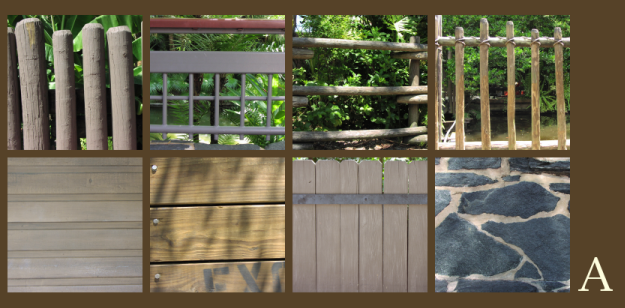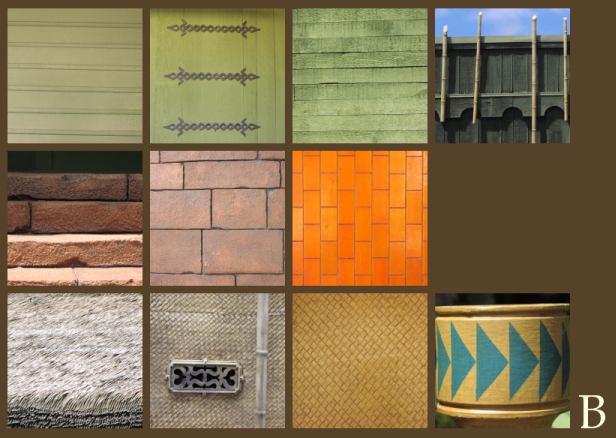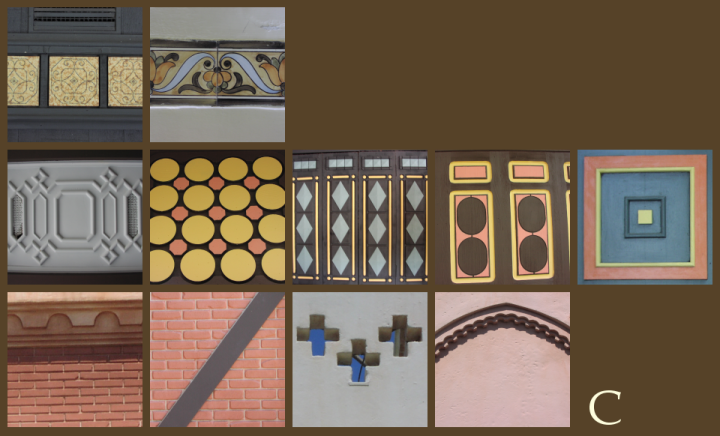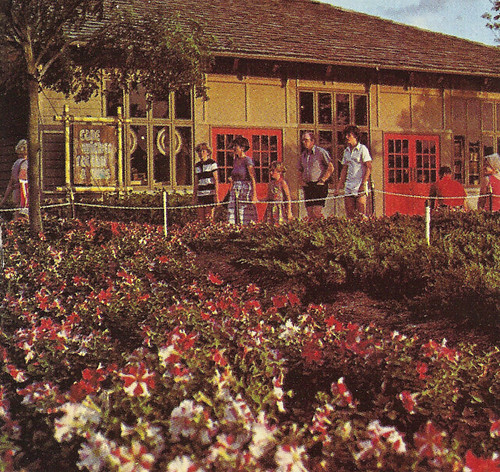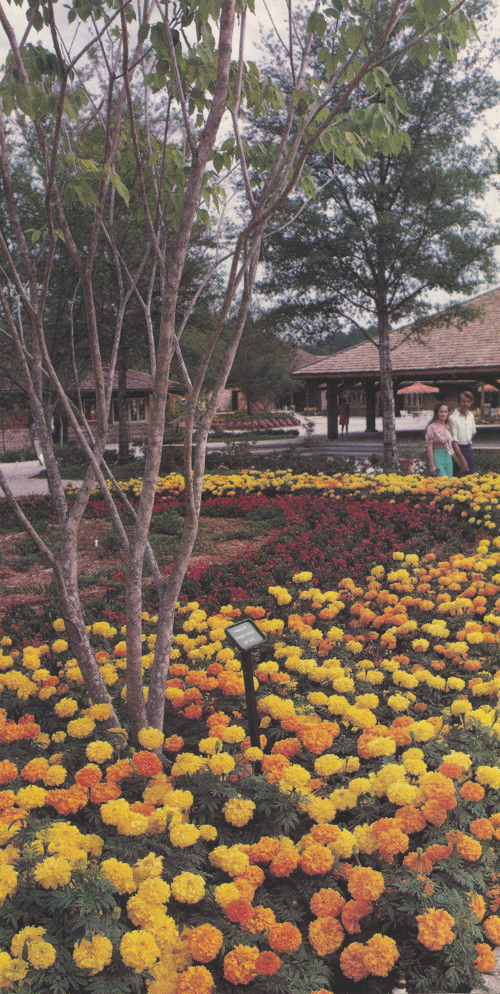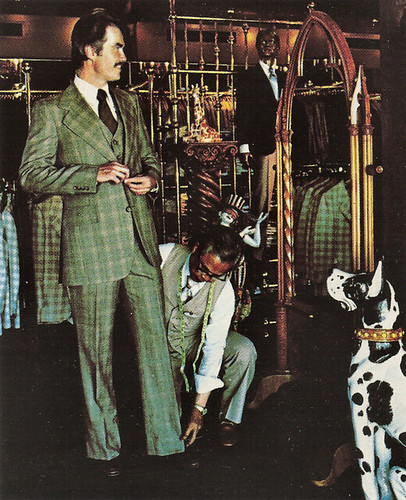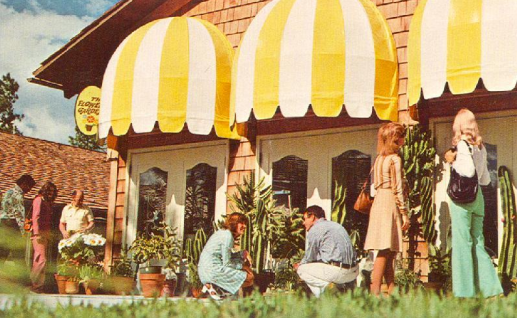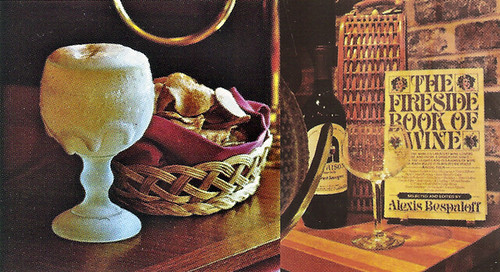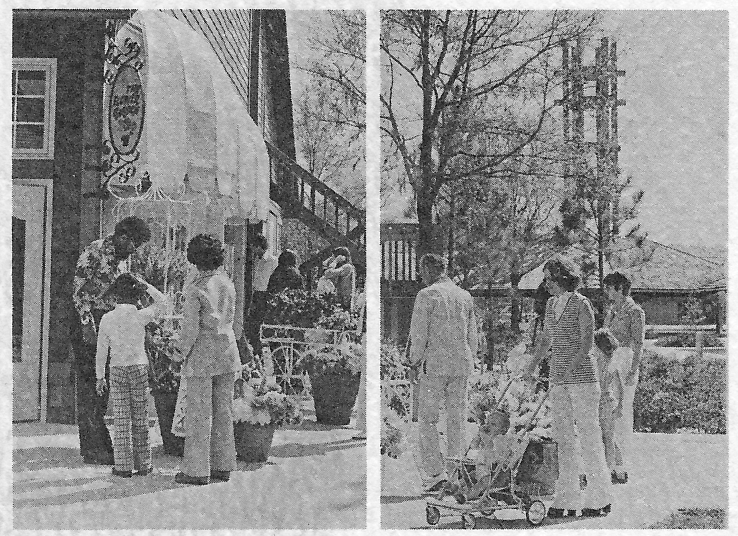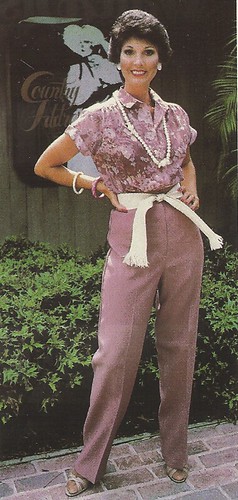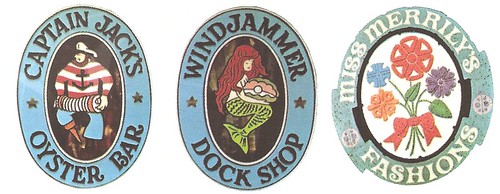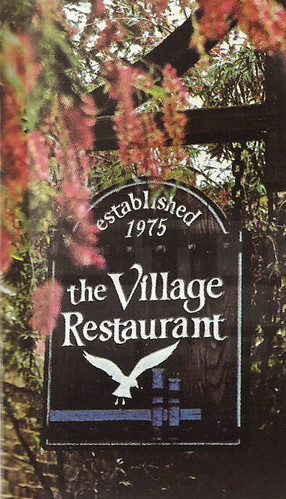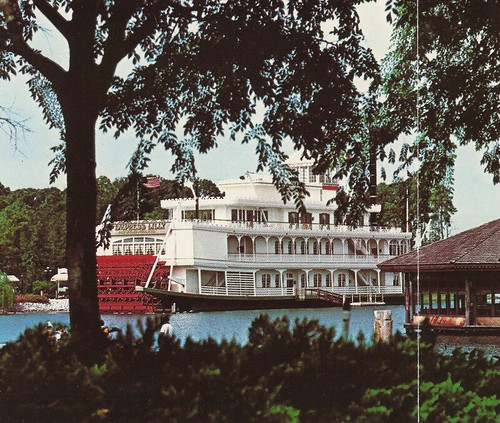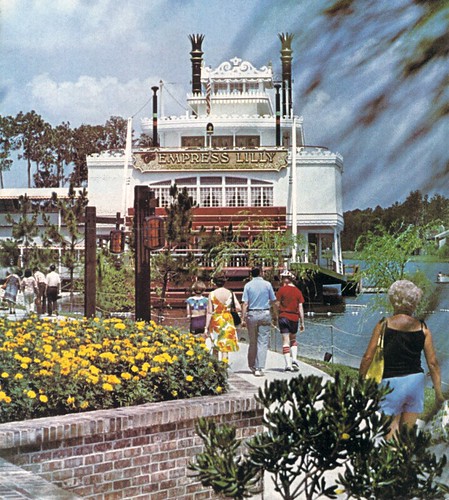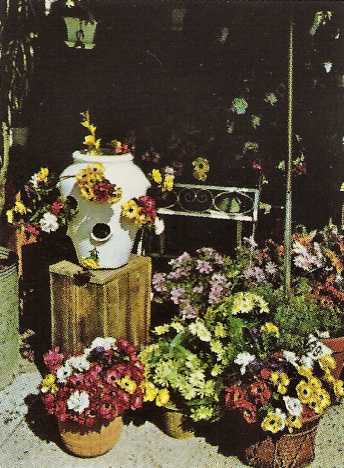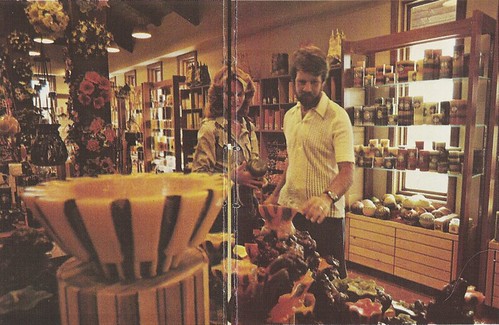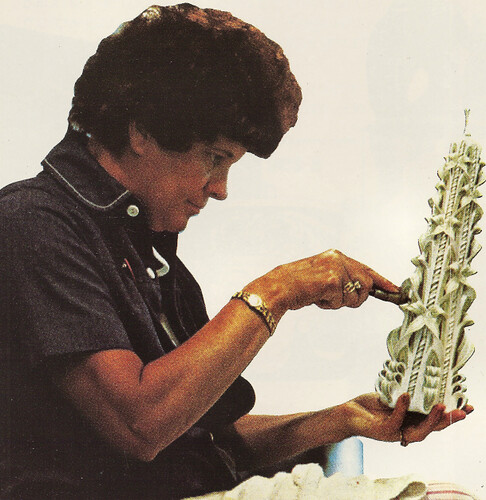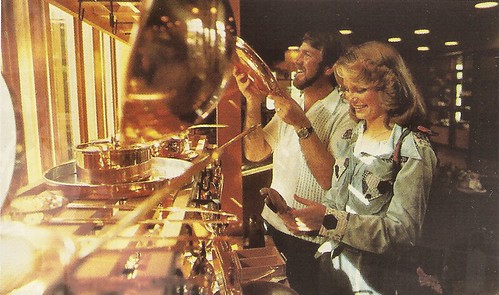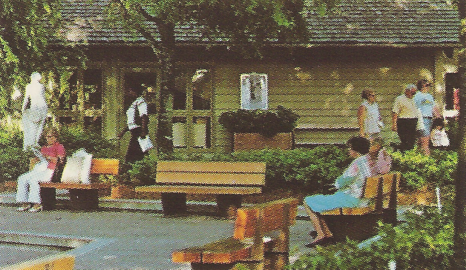 Please note: the following is not intended to reflect a tourist or touring-plan centric view of how Disney did this year: the various entertainment and operational cutbacks and sundry "cheap vacation" promotions have been well documented and discussed elsewhere. In keeping with the focus of this blog, the following is an appraisal of how the Magic Kingdom did in 2009 with an eye towards preservation and longevity and design. Enjoy.
Please note: the following is not intended to reflect a tourist or touring-plan centric view of how Disney did this year: the various entertainment and operational cutbacks and sundry "cheap vacation" promotions have been well documented and discussed elsewhere. In keeping with the focus of this blog, the following is an appraisal of how the Magic Kingdom did in 2009 with an eye towards preservation and longevity and design. Enjoy.ADDITIONS AND ALTERATIONS, JAN - DEC 2009
Golden Oak Outpost - This incongrouous little food outlet opened across from Pecos Bill right at the start of this year after nearly eight months of work on the berm and surrounding areas to the south of Splash Mountain, and as a food addition to the West side of the park, it's fine. I've already spoken extensively back in July about what it does thematically to the Frontierland / Caribbean Plaza transition, and there's still themeing details I enjoy, like a new paving detail surrounding the cattle pen / seating area which indicates where some walls have been taken down, and a central millstone / seating area which looks exactly like the circular, mule-drawn millstone you see in a couple of Sergio Leone's westerns. Lee Van Cleef could appear on horseback at any moment.
What is important to speak about in relationship to the Golden Oak Outpost is how it is emblematic of how Disney's old, foolish mistakes are coming back to bite them. In 1994, Disney shuttered the Adventureland Veranda and proceeded to gut its' kitchen, constructing a wall between the old kitchen and service areas and integrating the remaining kitchen area into the Liberty Tree Tavern kitchen. At the same time, another kitchen was walled in upstairs at the Columbia Harbour House, which had been just scraping by on selling baked potatoes for a few years anyway. There was even serious consideration of closing the entire Harbour House. In 2003, Eisner cut all entertainment equity from Liberty Square, which brought with it the removal of all Liberty Square characters and musical entertainment, including the Diamond Horseshoe Saloon Revue. Character entertainment took over the Horseshoe with a poorly-received Goofy themed show, and soon the Diamond Horseshoe was closed too, removing another food option from the West side of the park. Most of the time it's up to just Pecos Bill and Harbour House to shoulder the weight of lunch rush on that side of the Magic Kingdom, and based on how flooded these places can become, it's doubtful now that Disney thinks so much of having permanently removed the Veranda's ability to prepare meals fifteen years ago.
And so we now have a temporary food location inside the Diamond Horseshoe, which has been beautifully restored but still lacks a stage show. Outdoor Foods and Liberty Tree Tavern tag-team operation of food locations here. El Pirata Y El Perico apparently doesn't attract the crowds when it is open, and so we have borne Golden Oak Outpost as a fix for shouldering the burden of food rushes. An impromptu collection of food wagons in Liberty Square make up for the lack of a real place to eat between the Hall of Presidents and Pecos Bill.
In the next few years, Disney needs to get her act together and fix up the Veranda, a prime location with excellent capacity, and reopen it as a place to get a meal in Adventureland, since for most of the year, your only options are Dole Whips and Citrus Swirls and corn dogs. That's no way to run a land. As a emblem of this issue, I sort of resent the Golden Oak Outpost. But as a piece of design, it's very well done and a worthy addition to Frontierland. GRADE: C+
Tinkerbell's Treasures - This shop closed quietly early this year and returned in April or May as a surprisingly interesting remake of one of the Magic Kingdom's most appealingly quiet shops. The "Tinkerbell" portion of the shop has always been pretty nice, but the remaining half, themed to Peter Pan, has always looked closer to the children's department of a J. C. Penny circa 1984 than something you'd find at Walt Disney World. While the Tinkerbell section simply recieved an aesthetic facelift to bring it closer to the image of Ms. Bell as depicted in current CGI endeavors, the Peter Pan section has become something called Castle Couture, something like the dress headquarters for the Bibbity Bobbity Boutique (you have no idea how painful it was to type that) across the way. It's very well done, if a tad overt, complete with a hotline to the boutique at the back of the store, between the dressing rooms. As one of Disney's most profitable ventures in the parks in the last few years, perhaps the Boutique overlay was inevitable. But at least it was done well, with a refined European atmosphere inside, rich woods, and vibrant colors - far classier, in fact, than the Boutique itself. The color changing dress effect won't fool any of the little gals running around inside, but it's still a lot of fun to see. GRADE: C
Pirate's League - Speaking of the B.B.Boutique... here's the boys version, and although the necessity of it is questionable (perhaps bore out by the concept's failure to ignite the general public in the way that the Boutique has), as a piece of design it's absolute gangbusters. From a clever entrance area to a dusky, murky, interesting face painting area and a (supposedly) exciting photo area, the only thing that has doomed this project to failure is the passing nature of the current Pirate fad, already starting to die out, it seems. Disney seems willing to rise or fall on their ability to keep Captain Jack afloat, and the success of the upcoming fourth movie may be the thing that keeps the Pirate's League open in the next five years. But you'll still see a number of little kids running around in Pirate gear during any given day at the Magic Kingdom, so it can't be a total wash. If we take the Bruckheimerization of Caribbean Plaza as an inevitability due to the rampant success of a certain trilogy of noisy movies, it could be done a lot worse and much more annoyingly. Let's hope Disney has the foresight to have a contingency plan in case they need to strip out the movie trilogy themeing in the next few years and put in some Disney pirates who have proven to have had some more staying power, like Captain Hook or Long John Silver. GRADE: B
 Hall of Presidents -
Hall of Presidents -"You don't put music behind the Gettysburg Address.
The Gettysburg Address is music." - Charles Laughton
The Gettysburg Address is music." - Charles Laughton
One of the two big "centerpieces" of Disney's efforts this year to keep the Magic Kingdom evergreen, The Hall of Presidents, historically, has attracted so little respect on Disney's part that one wouldn't think that it would constitute the most impressive resuscitation effort on property for 2009, but that's what happened. Hall of Presidents admirers shouldn't sneer - that the closure of the show for eight months would not effect the front gate profits is probably what allowed her to receive a lavish, expensive, carefully controlled update as opposed to the somewhat strained facelift that the profit-driver Space Mountain ended up with. Supposedly, nearly twice as much was spent on the Hall of Presidents, much of it being spent on her three cutting edge digital projectors. But I digress.
Back in 2008 I made a stack of suggestions about the show which I painfully carefully tried to avoid phrasing as "please put the 1971 show back in", but that's what many of them boiled down to. A lot of these concepts were based on the assumption that the show would pretty much not get a new film, which back in mid 2008 as far as we all knew was going to be the plan. But that's not what happened, and what's currently running in Florida now is perhaps best not thought of as a "new Hall of Presidents show", in the way that the Tony Baxter led Mr. Lincoln in Disneyland is a "new Lincoln show", but more of "a new show that uses parts of the Hall of Presidents". This is a bold move that I frankly didn't expect WDI to take, but it is absolutely essential if the show is to remain relevant and interesting. As much as I'm a traditionalist for WED's brilliant era of design, I'd rather see something new and well done carry the baton onward and keep these important shows drawing people in.
For the last quarter century the role of the Hall of Presidents has been in flux, since the opening of the American Adventure at EPCOT created some redundancy in concept between the two shows. The Hall of Presidents' role as an examination of the United States Constitution was further dulled by a 1993 redo which inserted paintings created for the American Adventure which covered much of the same ground. This 2009 version deconstructs the formula of the 1971 original, which the 1993 version more or less adhered to, and reconstructs the show not around the Constitution and the Bill of Rights, but around the general role of the Presidency as a spokesperson for the times. Along the way it sometimes takes the form of a Presidential trivia show, but throughout the show is remarkable in how many, if not individual scenes, important moments from the 1971 show it revives. Once again, for the first time in sixteen years, those big blue curtains part to reveal a window into history, and do so at the right moments.
But these designers were not slaves to the James Algar version of the show, and there has been an effort not only to keep what worked about the old version but put everything that seemed to be workable into a new place or new context. The show seems to be pretty similar to the 1971 version until about seven minutes in, when Lincoln sudden appears all by himself on stage to deliver the Gettysburg Address. This is not only a fantastic optical illusion achieved with moving curtains which accents and enhances the "layered" lifting of a curtain on history which was the signature style of the original show, but it frees the show of its' decades-long obligation to end the show with a Lincoln speech which summarizes the "lesson" of the presentation. There was some talk of removing the current President's speech at the end, a move which I supported, assuming that Lincoln would always wrap up the show. But in moving Lincoln's key speech to the midway point and changing it to his most famous historical speech rather than an amalgamation of inspiring passages from other speeches and letters, the balance of having the current President speak is restored. It makes sense to have spoken passages by Washington, Jackson, Lincoln, and finally our current President. And once that center screen lifts and Lincoln, apparently isolated on stage, stands to address the audience, the show throws out all the rules.
The second half of the film presentation is a little hard to assess at this point since we've only been living with it for a few months rather than years and years, and it does correct a longtime problem with the show, which is incomplete and unsatisfying coverage of events following the Civil War. By finally tackling issues like the Great Depression and Civil Rights, the show's credibility skyrockets, and had it ended following the Kennedy section of the film, it would've been sent off on a high note. But the film then goes and does something which I'm not sure is commendable or unfortunate, which is suddenly shift focus from an emphasis on the President in key transitional periods for the United States to the role of the Presidency in moments of political crisis, which seems to be a way to quickly touch on more recent events without going into a whole section on, say, Regan. I think it's a wise move to touch on the more recent Presidents in a simple way, but going heavyhanded into three-hankie territory is what happens, and I never know if the audience goes with it or not. It is sort of the part of the show that everyone coughs through awkwardly, and is the biggest disappointment in an overall ace refreshment.
The presidents as always inspire awe and fascination, and the inclusion of Washington in a speaking role work remarkably well; hearing his 'voice' in the new film and then again coming out of the 'real thing' makes the entire "great cavalcade of history" all the more awe inspiring, and seeing George Washington turn to address Barack Obama with Abe Lincoln seated between them is the sort of "only at Disney" moment that too many current Disney attractions lack. Later in the show Lincoln turns to Washington, who nods quietly in approval as the curtains close. Clinton checks his watch. George w. Bush gets lint on his coat and plucks it off. Jackson chats with Tyler thrughout the show. And James A. Garfield pats Chester A. Arthur on the back, presumably to thank him for taking over his office when Garfield was assassinated. As the show wraps up, not with the traditional Battle Hymn of the Republic, but with a soaring version of America the Beautiful, and the night sky behind the capitol dome becomes not a dawn sky stylized to look like an American flag but an actual American flag billowing in the breeze, this moment becomes emblematic of the whole show. It's not traditional, and it's therefore sort of risky. But it's easy to be traditional and succeed. It's far harder to be new and succeed. The Hall of Presidents has it both ways. It's probably Disney's star attraction of the year. GRADE: A-
Riverboat / Princess Invasion - Disney went into full-bore marketing onslaught mode this year, and it seems to have worked, even if nobody seems to know the name of the new Princess, where her show is, or the name of her movie. What people do know is that whatever it is, they're obligated to be interested in it, and one of their most publicly successful efforts this year has been importing the Showboat Jubilee show from Disneyland. Although I'm not exactly sold, as always, on the actual quality of Walt Disney World Entertainment's productions - and remember, quality is different from expense or lavishness - this one is better than most. Who knows, Captain Jack Sparrow's Pirate Tutorial grew on me as well. What is absurd and unavoidable about the show, however, is how inappropriate it is for Liberty Square. The show begins near the Diamond Horseshoe, at least, which at St. Louis is the most geographically south the Magic Kingdom gets, but proceeds through the middle of colonial Philadelphia and ends up passing a lot of other inappropriate structures along the way. At Disneyland, linked with New Orleans Square, it's appropriate and clever. But hearing the refrains of Randy Newman's jazz-inflected soundtrack blasting through Liberty Square is enough to do most of the damage for the show's credibility.
Strangely enough for those of us old enough to remember the first time this happened, the new Princess has set up shop behind the Christmas Shop with a fancy new gazebo, lamps, and lighting effects. At least it's better and more elaborate than the rickety wooden soap box Pocahontas got back in 1995, but it's essentially the same mistake: what's she doing here?
All of these protestations may be for nought, in the end, because good money has the odds on the show returning in a few months, and that's what the popular consensus seems to want. Seems like Walt Disney World has stuck their toes into Disney's Princess marketing phenomenon much more aggressively than anybody else, so we should've seen this coming... even if the idea of a jazz band marching up through Liberty Square continues to give me a nose bleed. GRADE: B-
WEDWAY Peoplemover - Yes, that's right, the Peoplemover, and it's even called that again in the new narration. The automated spiels around the park in general are badly in need of revision, and hopefully we'll finally ditch that rickety old codger on the Walt Disney World Railroad who's been hanging around for the last twenty-one years when the Toontown station becomes the Fantasyland station. The Peoplemover was no exception, and the shouted narration for the last fifteen years was no classic for those of us who grew up on the melodic strains of Jack Wagner or ORAC-1. It seems, in retrospect, that back in 1994 WDI was desperate to find some way to tie together the story of all the stuff they had put up all over Tomorrowland, and the Peoplemover was the easiest way to try to do it, by constantly shouting things that the attraction failed to contextualize or explain, like the 'Metro-Retro Historical Society' or 'Hover-burb Communities'.
Well all that's in the past now, thanks to a pleasantly low-key new narration which emphasizes the value of the things you're actually seeing, giving a shout-out to the 1964 World's Fair, Walt Disney, Progress City, and E.P.C.O.T. There's some new lights and stuff too, but the most important work was already done in replacing the audio. Short of giving us some more stuff to look at along the track, this minor effort has to be counted amongst the Magic Kingdom's best fixes this year for those of us who know that no matter how awesome Disneyland is, she still doesn't have a Peoplemover, which is about as important as the Haunted Mansion for a lot of us. GRADE: B
 Space Mountain - So yeah. This one's gonna be tough, but I'd like to establish a few rules that should inform our future discussion of the Florida Space Mountain.
Space Mountain - So yeah. This one's gonna be tough, but I'd like to establish a few rules that should inform our future discussion of the Florida Space Mountain.1. Florida Space Mountain is not the California Space Mountain.
2. Florida Space Mountain is not the California Space Mountain. It never will be.
3. Florida Space Mountain is not the California Space Mountain. Move on with your lives.
4. Florida Space Mountain is not the California Space Mountain. And that's valuable.
2. Florida Space Mountain is not the California Space Mountain. It never will be.
3. Florida Space Mountain is not the California Space Mountain. Move on with your lives.
4. Florida Space Mountain is not the California Space Mountain. And that's valuable.
Fact is that the original '75 Space Mountain gets no respect for what it is rather than what it bore out. As a concept, it took WED a few years to weed the weirdness out of the Space Mountain concept, and the original Mountain still contains all this weirdness, warts and all. Open Load Area? Why not, it seemed cool at the time. Weird show scenes along the main lift hill? Heck Yes. Two tracks? Why not. Elaborate pre-show and post show? Absolutely essential. What's funny about the popular differences in conception between the two Space Mountain variations in the United States is that the Florida Space Mountain is denigrated for the same reasons the California Pirates of the Caribbean is celebrated: their excessive strangeness, their overflowing of ideas and creativity. Conversely, the California Space Mountain is pretty much similar to the Florida Pirates of the Caribbean in that they may not be as impressive or special as the originals, but they contain certain design changes and re-conceptualizations that improve on components of the overall show experience. What may not be better does show indications of being a second design iteration.
Which brings us to the huge disappointment of this year's Space Mountain redo for myself and many others, which is the lack of an onboard music system in each rocket. But after riding the redo a few times, you know what? I'm over it. Because, for myriad reasons, the Florida Space Mountain is the version which needs an onboard audio system the least.
One of these reasons is the hugely elaborate pre-show and post-show, which constitute two-thirds of the overall Space Mountain experience in Florida. The 1975 Space Mountain draws you slowly through dark tunnels, past starry windows, strange Pepper's Ghost effects, then slowly nearer and nearer the rockets, a remarkable experience which nearly makes one forget that's she's in a big weird white cone in Florida. In California, Tokyo and elsewhere you queue in the sun outside, go down two short corridors, get in your rocket and go. When you disembark you stumble down a short hallway and end up back outside in Tomorrowland, rather than ride a long moving belt past strange scenes of alien landscapes to slowly bring you back to the concrete and chrome reality of Tomorrowland. In this context the California rollercoaster needs to be as impressive, slick and nice as possible, because there's nothing else to the experience. What else do you say about a version of the ride which isn't even in a freestanding building, but housed in a halfsize facade tacked onto the back of a patio? The experience of the Florida version, taken as a whole, is immersing, intoxicating and unique.
Similarly there is some cosmic justice that the Florida Space Mountain, through error or circumstance, presents a fairly accurate version of what it was like to ride it in 1975, just as the original Tiki Room plays on in its original venue while other Disney colonies must be content with bastardized versions. When we discredit the notion that Walt Disney World history is less valuable than Disneyland history, then the lack of onboard audio in the version of Space Mountain which would benefit from it least becomes something almost commendable; history rather than heresy.
OK, so I've gone to great lengths to defend a very unpopular opinion. What about the rest of it?
It's all good. The weirdness of the ride has been lovingly restored, and those video games in the queue are fun and not too distracting from the strange and lovely atmosphere. The track has been greatly smoothed out in certain patches, although the ride is still as rough and scary as it was designed to be in 1975. That I, the rollercoaster allergic, prefer the smoothness and fun of the Disneyland track should be noted, just as much as it's important to note that the differences were designed into the tracks to begin with. The post show scenes finally make sense and don't seem to be leftovers from the FedEx days like they've been for the past few years, and there's some nice EPCOT homages in there that make me happy.
There's two final things I'd like to say about this redo. First is that the new projection domes atop the load areas are fascinating optical effects that only fall apart from certain angles, but are the nearest we've gotten so far in 21st century Imagineering to Yale Gracey's immortal and always fascinating cloud effects from 1965. The second is that the attraction now includes a command to "CHECK (the) INVISIBLE OXYGEN DOME", a line as silly and whimsical and enchanting as anything Disney has given us since the early 1990's. Bringing fun, whimsy, fascination and adventure back into a ride which was starting to feel like an operating artifact is no small feat, and so I give this attraction refurbishment huge credit. It may not have done a lot, but everything it did do was important and relevant and excellently judged. GRADE: B+
ADDITIONS AND ALTERATIONS AVERAGE SCORE: B
PARK UPKEEP AND MAINTENANCE, 2009
Huge improvements in 2009. You may need to be as detail obsessive as I to notice these things, but it seems like Disney finally remembered that they have a dedicated onsite staff of painters and woodworkers and electricians who sit behind Small World all day smoking cigarettes. In the last year windows, doors, props, set dressing, lights, gables, cupolas and all other manner of stuff has vanished suddenly from Magic Kingdom facades only to return days later looking exactly as it did before - except that they've been made entirely out of new materials. Every window and gable on the outside of the Hall of Presidents is new, for example, as are a few of the doors. Main Street's shops got new entryways a few times over this year, and lighting fixtures which were old, burned out, and electrically unsound are being slowly removed, refurbished, and replaced. That you're unlikely to notice this stuff as it's being done is testament to how well it has been done.
Set dressing has similarly been greatly improved. I talked about this a bit in July but everything from themed crates to silk flowers has been refreshed regularly, and coats of paint are becoming more and more common. Pinnochio's Village Haus has had all her facade lights turned back on, and with all those fake windows lit up again she no longer looks like an abandoned hulk at night. It's safe to say that if things stay this way and escalate along current trends, no stone should be unturned by the time we reach the park's anniversary in 2011. We're not back to those standards we had when people like Dick Nunis were in charge of the place, but to say that the Magic Kingdom looks better, fresher, and less dingy than when I was visiting in the 90's is a severe understatement.
Landscaping still leaves something to be desired, with a plethora of "leafy green and red" stuff instead of flowerbeds and flowers, but really the biggest offenders are not those who put in the flowers and maintain them, but those who are in charge of keeping trees, bushes, grass and other vegetation in check. Sightlines all across the park are compromised by excessive tree growth. A shaded, leafy glen is desirable in some places and not others, and things like the miniature forest which has spring up around Big Thunder Mountain, a veritable tangle of trees and shrubs which have engulfed a nearby Disney rock formation near Beacon Joe, and a Haunted Mansion that's starting to look more like a Slightly Possessed Shrub all need attention.
It's hard to make a unilateral call since the actual upkeep of the attractions themselves depends on department, staff, budget and resources, but I feel like things have certainly not gotten worse and possibly improved significantly in the last couple of months. Whether there has been a money infusion into Buildings Maintainence or not I can no longer attest to, but somebody out there is putting extra time and money into the Magic Kingdom. Let's hope it stays that way. GRADE: A-
COMMENTS: The Magic Kingdom is very popular, and spends a lot of time with her friends. But her schoolwork seems to be suffering for it. It seems like she's rushing through her assignments instead of doing them carefully, slowly and right the first time. With more effort and care her grades could be as good as her reputation. Does she have a happy home life? -Foxx Fur
Which brings us to the huge disappointment of this year's Space Mountain redo for myself and many others, which is the lack of an onboard music system in each rocket. But after riding the redo a few times, you know what? I'm over it. Because, for myriad reasons, the Florida Space Mountain is the version which needs an onboard audio system the least.
One of these reasons is the hugely elaborate pre-show and post-show, which constitute two-thirds of the overall Space Mountain experience in Florida. The 1975 Space Mountain draws you slowly through dark tunnels, past starry windows, strange Pepper's Ghost effects, then slowly nearer and nearer the rockets, a remarkable experience which nearly makes one forget that's she's in a big weird white cone in Florida. In California, Tokyo and elsewhere you queue in the sun outside, go down two short corridors, get in your rocket and go. When you disembark you stumble down a short hallway and end up back outside in Tomorrowland, rather than ride a long moving belt past strange scenes of alien landscapes to slowly bring you back to the concrete and chrome reality of Tomorrowland. In this context the California rollercoaster needs to be as impressive, slick and nice as possible, because there's nothing else to the experience. What else do you say about a version of the ride which isn't even in a freestanding building, but housed in a halfsize facade tacked onto the back of a patio? The experience of the Florida version, taken as a whole, is immersing, intoxicating and unique.
Similarly there is some cosmic justice that the Florida Space Mountain, through error or circumstance, presents a fairly accurate version of what it was like to ride it in 1975, just as the original Tiki Room plays on in its original venue while other Disney colonies must be content with bastardized versions. When we discredit the notion that Walt Disney World history is less valuable than Disneyland history, then the lack of onboard audio in the version of Space Mountain which would benefit from it least becomes something almost commendable; history rather than heresy.
OK, so I've gone to great lengths to defend a very unpopular opinion. What about the rest of it?
It's all good. The weirdness of the ride has been lovingly restored, and those video games in the queue are fun and not too distracting from the strange and lovely atmosphere. The track has been greatly smoothed out in certain patches, although the ride is still as rough and scary as it was designed to be in 1975. That I, the rollercoaster allergic, prefer the smoothness and fun of the Disneyland track should be noted, just as much as it's important to note that the differences were designed into the tracks to begin with. The post show scenes finally make sense and don't seem to be leftovers from the FedEx days like they've been for the past few years, and there's some nice EPCOT homages in there that make me happy.
There's two final things I'd like to say about this redo. First is that the new projection domes atop the load areas are fascinating optical effects that only fall apart from certain angles, but are the nearest we've gotten so far in 21st century Imagineering to Yale Gracey's immortal and always fascinating cloud effects from 1965. The second is that the attraction now includes a command to "CHECK (the) INVISIBLE OXYGEN DOME", a line as silly and whimsical and enchanting as anything Disney has given us since the early 1990's. Bringing fun, whimsy, fascination and adventure back into a ride which was starting to feel like an operating artifact is no small feat, and so I give this attraction refurbishment huge credit. It may not have done a lot, but everything it did do was important and relevant and excellently judged. GRADE: B+
ADDITIONS AND ALTERATIONS AVERAGE SCORE: B
PARK UPKEEP AND MAINTENANCE, 2009
Huge improvements in 2009. You may need to be as detail obsessive as I to notice these things, but it seems like Disney finally remembered that they have a dedicated onsite staff of painters and woodworkers and electricians who sit behind Small World all day smoking cigarettes. In the last year windows, doors, props, set dressing, lights, gables, cupolas and all other manner of stuff has vanished suddenly from Magic Kingdom facades only to return days later looking exactly as it did before - except that they've been made entirely out of new materials. Every window and gable on the outside of the Hall of Presidents is new, for example, as are a few of the doors. Main Street's shops got new entryways a few times over this year, and lighting fixtures which were old, burned out, and electrically unsound are being slowly removed, refurbished, and replaced. That you're unlikely to notice this stuff as it's being done is testament to how well it has been done.
Set dressing has similarly been greatly improved. I talked about this a bit in July but everything from themed crates to silk flowers has been refreshed regularly, and coats of paint are becoming more and more common. Pinnochio's Village Haus has had all her facade lights turned back on, and with all those fake windows lit up again she no longer looks like an abandoned hulk at night. It's safe to say that if things stay this way and escalate along current trends, no stone should be unturned by the time we reach the park's anniversary in 2011. We're not back to those standards we had when people like Dick Nunis were in charge of the place, but to say that the Magic Kingdom looks better, fresher, and less dingy than when I was visiting in the 90's is a severe understatement.
Landscaping still leaves something to be desired, with a plethora of "leafy green and red" stuff instead of flowerbeds and flowers, but really the biggest offenders are not those who put in the flowers and maintain them, but those who are in charge of keeping trees, bushes, grass and other vegetation in check. Sightlines all across the park are compromised by excessive tree growth. A shaded, leafy glen is desirable in some places and not others, and things like the miniature forest which has spring up around Big Thunder Mountain, a veritable tangle of trees and shrubs which have engulfed a nearby Disney rock formation near Beacon Joe, and a Haunted Mansion that's starting to look more like a Slightly Possessed Shrub all need attention.
It's hard to make a unilateral call since the actual upkeep of the attractions themselves depends on department, staff, budget and resources, but I feel like things have certainly not gotten worse and possibly improved significantly in the last couple of months. Whether there has been a money infusion into Buildings Maintainence or not I can no longer attest to, but somebody out there is putting extra time and money into the Magic Kingdom. Let's hope it stays that way. GRADE: A-
COMMENTS: The Magic Kingdom is very popular, and spends a lot of time with her friends. But her schoolwork seems to be suffering for it. It seems like she's rushing through her assignments instead of doing them carefully, slowly and right the first time. With more effort and care her grades could be as good as her reputation. Does she have a happy home life? -Foxx Fur



